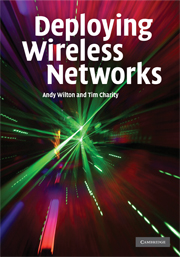Book contents
- Frontmatter
- Contents
- Foreword by Sir David Brown, FREng
- Preface
- Acknowledgements
- Authors' disclaimer
- 1 Introduction
- 2 Wireless network systems
- 3 Principles of access network planning
- 4 Introduction to RAN planning and design
- 5 GSM RAN planning and design
- 6 UMTS RAN planning and design
- 7 Cellular OFDM RAN planning and design
- 8 Mesh network planning and design
- 9 Core network and transmission
- 10 Network operation and optimisation
- Acronyms
- Index
- References
6 - UMTS RAN planning and design
Published online by Cambridge University Press: 13 August 2009
- Frontmatter
- Contents
- Foreword by Sir David Brown, FREng
- Preface
- Acknowledgements
- Authors' disclaimer
- 1 Introduction
- 2 Wireless network systems
- 3 Principles of access network planning
- 4 Introduction to RAN planning and design
- 5 GSM RAN planning and design
- 6 UMTS RAN planning and design
- 7 Cellular OFDM RAN planning and design
- 8 Mesh network planning and design
- 9 Core network and transmission
- 10 Network operation and optimisation
- Acronyms
- Index
- References
Summary
In the early 1990s, the need for a ‘third-generation’ cellular standard was recognised by many agencies worldwide. The European Union had funded a series of research programmes since the late 1980s, such as RACE [1], aimed at putting in place the enabling technology for 3G, and similar work was underway in Japan, the USA and other countries. The runaway success of GSM, however, had fortuitously put ETSI in the driving seat, as most countries wanted a GSM-compatible evolution for 3G. Recognising this need, and to reduce the risk of fragmented cellular standards that characterised the world before GSM, ETSI proposed that a partnership programme should be established between the leading national bodies to develop the new standard. The result was the formation of 3GPP (the 3G Partnership Programme) between national standards bodies representing China, Europe, Japan, Korea and the USA. It was agreed that ETSI would continue to provide the infrastructure and technical support for 3GPP, ensuring that the detailed technical knowledge of GSM, resident in the staff of the ETSI secretariat, was not lost.
Although not explicitly written down in the form of detailed 3G requirements at the time, the consensus amongst the operator, vendor and administration delegates that drove standards evolution might best be summarised as:
Provide better support for the expected demand for rich multimedia services,
Provide lower-cost voice services (through higher voice capacity),
Reuse GSM infrastructure wherever possible to facilitate smooth evolution.
This was clearly a very sensible set of ambitions, but limited experience of multimedia in the fixed network, and of the specific needs of packet-based services in particular, meant that some aspects of the resulting UMTS standard were not ideal.
- Type
- Chapter
- Information
- Deploying Wireless Networks , pp. 147 - 221Publisher: Cambridge University PressPrint publication year: 2008



